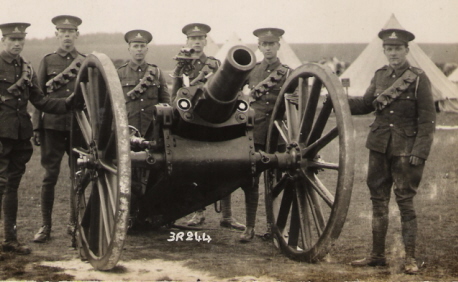 The Ordnance QF 4.5 inch Howitzer was the standard British Empire field (or ‘light’) howitzer of the First World War era. It replaced the BL 5 inch Howitzer
The Ordnance QF 4.5 inch Howitzer was the standard British Empire field (or ‘light’) howitzer of the First World War era. It replaced the BL 5 inch Howitzer and equipped some 25% of the field artillery. It entered service in 1910 and remained in service through the interwar period and was last used in the field by British forces in early 1942. It was generally horse drawn until mechanisation in the 1930s. It was used by British and Commonwealth Forces in most theatres, by Russia and by British troops in Russia in 1919. Its calibre (110mm) and hence shell weight were greater than those of the equivalent German field howitzer (105mm), France did not have an equivalent.
and equipped some 25% of the field artillery. It entered service in 1910 and remained in service through the interwar period and was last used in the field by British forces in early 1942. It was generally horse drawn until mechanisation in the 1930s. It was used by British and Commonwealth Forces in most theatres, by Russia and by British troops in Russia in 1919. Its calibre (110mm) and hence shell weight were greater than those of the equivalent German field howitzer (105mm), France did not have an equivalent. In the Second World War it equipped some units of theBEF and British, Australian, New Zealand and South African batteries in East Africa and the Middle and Far East.During the Second Boer War (1899–1902) the British government realised its field artillery was being overtaken by the more modern "quick firing" guns and howitzers of other major powers. The Krupp field howitzers used by the Boers had particularly impressed the British. The usefulness of field howitzers and the need for them to form part of an infantry division’s artillery were reinforced by reports from the Russo-Japanese War in 1904. In 1900 Cabinet ordered Field Marshal Lord Roberts, the Commander-in-Chief in South Africa to send home artillery brigade and battery commanders “selected for their eminence and experience” to form an Equipment Committee. The committee was chaired by General Sir George Marshall, who had been artillery commander in South Africa. It formed in January 1901 with wide ranging terms of reference concerning artillery equipment from guns and howitzers to harness design and instruments.
In the Second World War it equipped some units of theBEF and British, Australian, New Zealand and South African batteries in East Africa and the Middle and Far East.During the Second Boer War (1899–1902) the British government realised its field artillery was being overtaken by the more modern "quick firing" guns and howitzers of other major powers. The Krupp field howitzers used by the Boers had particularly impressed the British. The usefulness of field howitzers and the need for them to form part of an infantry division’s artillery were reinforced by reports from the Russo-Japanese War in 1904. In 1900 Cabinet ordered Field Marshal Lord Roberts, the Commander-in-Chief in South Africa to send home artillery brigade and battery commanders “selected for their eminence and experience” to form an Equipment Committee. The committee was chaired by General Sir George Marshall, who had been artillery commander in South Africa. It formed in January 1901 with wide ranging terms of reference concerning artillery equipment from guns and howitzers to harness design and instruments.
No comments:
Post a Comment